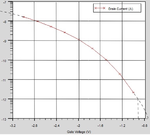Follow along with the video below to see how to install our site as a web app on your home screen.
Note: This feature may not be available in some browsers.

extract name="nvt" (xintercept(maxslope(curve(abs(v."gate"),abs(i."drain"))))-abs(ave(v."drain"))/2)... in this paper Vth is taken to be -0.6V
but this code results nvt=1.7628 , which part of code is wrong?Code:extract name="nvt" (xintercept(maxslope(curve(abs(v."gate"),abs(i."drain"))))-abs(ave(v."drain"))/2)
this code is in example folder of software that calculate threshold voltage for a mosfetI don't know this code syntax, but ... doesn't the (ave(v."drain") expression need min/max limits for the average calculation?
And why don't simply take the intercept of the curve itself (instead of its maxslope) with a self-defined threshold current value?